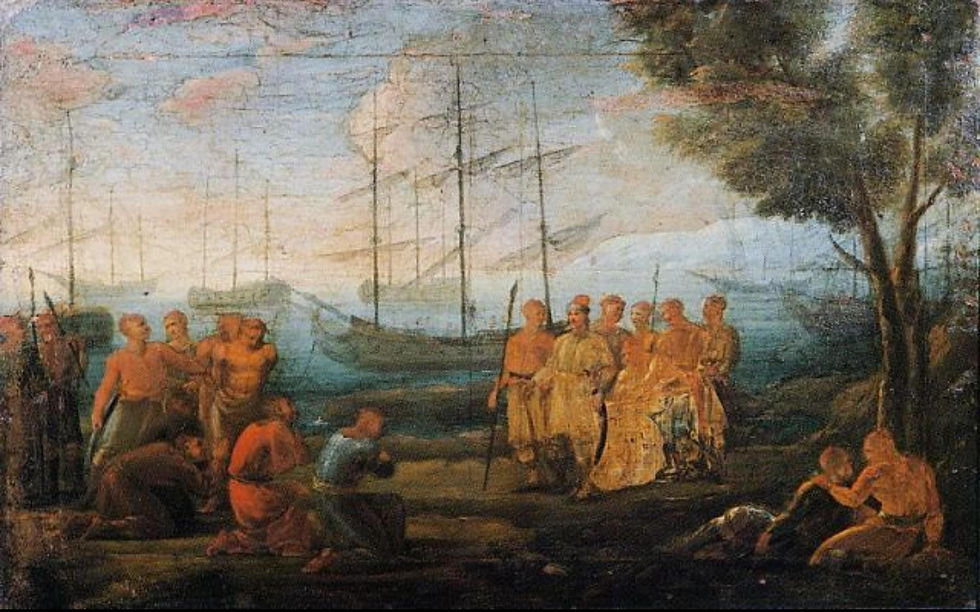D + 9: Where Nelson Lost his Right Eye
- hbanziger
- Jul 20, 2020
- 3 min read
Updated: Mar 26, 2021

Calvi in the early morning hours
Every morning when we wake up and meet for coffee on the deck, it is beautifully quiet, the air is still and no wave disturbs the flat surface of the sea. These morning hours are priceless. By nine the first hint of a wind can be felt and half an hour later, the day’s thermic system starts its daily routine. Warmer air rises along the steep mountain flanks, cooler air is drawn in from the sea. Ideal sailing conditions until about eight in the evening when the wind dies down and silence descends again. Even the waves splashing against the hull calm down.

Calvi viewed from the harbour
During the day, the wind strengthens to more than 20 knots and pushes the AFAET with force westwards. Yesterday, we used our sails to get from Saint-Florent to Calvi. Today we try to do the same again for the journey from Calvi to Giroleta. We should be making 6 knots per hour – or so we hope.

Turning One

Turning Two

Turning Three
Gliding silently along the Corsican coast provides ample time to look at the sturdy, reddish granite mountains which make up most of the coastline, the dense shrub that covers the rocks, the few fields that visibly stand out and the occasional village on a hilltop, always fortified with walls and watch tours. Life must have been tough here. Making a living on these mountains and defending the villages against the permanent threat of corsair raids must have left people with very little to enjoy. Before coming to Corsica, I tried to find out more about the island’s culture and music but was not too successful. Acapella multi-phonic singing is widespread here – maybe because the locals could not afford musical instruments? Difficult to say.

The typical reddish granite rocks on Corsica's west coast
The hardship of country life stands in sharp contrast to the magnificent citadel of Calvi, which towers over the last bay on Corsica's north that protects ships against the westerlies. No wonder a citadel was built here in1491. Usually, the Genovese authorities asked the local population to shoulder the cost of fortifying and garrisoning a place. But the citadel of Calvi is too big for the local economy. I guess it must have been subsidized due to its strategic location. Calvi Semper Fidelis – Calvi Always Faithful is carved above the main town gate – maybe as a thank you to the Genovese for footing the bills!

The mighty bastion protecting the entrance to Calvi

Calvi's church at the centre of the old town
Today. Calvi is one of the best maintained Genovese towns in the Mediterranean. It survived because it became strategically irrelevant after the Napoleonic wars. The French had conquered Northern Africa, the threat of corsair raids was gone and the French run Corsica from Ajaccio. Calvi was so remote it was chosen as training center for the Paras of the Foreign Legion. The town had dropped into the doldrums of history until it was re-discovered by tourism who loved the scenic, unspoiled old town. For the second time after Saint-Florent, we met a lot of French vacationers. At least a few places seem to get some sort of a tourist season.

Busy Main Street of Calvi today
Calvi has two other claims to world history. Some people think that Christoph Columbus was born here – the claim is a bit dubious. The other one is more serious. Admiral Nelson lost his right eye here during the siege of Calvi by the Royal Navy in 1794 when splinters caused by enemy fire hit him.

British (red) and French (blue) forces at the siege of Calvi in 1794
For now, it is time to set sail and move to Girolata where we are going to stay for the night

Our skipper, Captain Nikos, sailing us out the harbour of Calvi







Comments